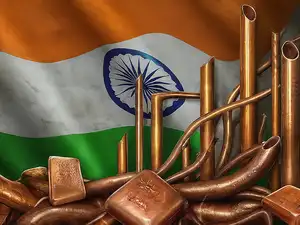 TIL Creatives
TIL CreativesWhile copper isn’t infallible and its price can be influenced by factors like speculation, supply disruptions or geopolitical tensions, it remains a widely watched barometer of global economic activity.
US President Donald Trump has recently announced a 50% tariff on all copper imports into the United States, citing national security and the need to rebuild America’s industrial base. "Copper is necessary for Semiconductors, Aircraft, Ships, Ammunition, Data Centers, Lithium-ion Batteries, Radar Systems, Missile Defense Systems, and even Hypersonic Weapons, of which we are building many," Trump said in a post on Truth Social. The move sent immediate shockwaves through financial markets and global trade networks.

The tariffs are said to include all refined metal, Bloomberg has reported, citing people familiar with the matter. They would also include semi-finished products such as those used for power grids, the military and data centers.
Major copper-exporting countries like Chile, Peru, Mexico and Canada could see declining demand from one of their largest markets. At the same time, global copper prices are likely to face downward pressure as surplus supply is redirected elsewhere. Arbitrage opportunities may also arise as the price of copper in the US decouples from international markets.
Trump’s administration has justified the tariff on the grounds of national security, claiming copper is vital for defense and critical infrastructure. However, critics argue that the move is a protectionist gesture unlikely to meaningfully boost domestic output in the short term. Instead, it may exacerbate supply chain disruptions and spark retaliation from trade partners.
An industry official told PTI that Trump's proposed 50 per cent import tariff on copper will not have any impact on Indian companies as the country is copper-deficient.
International Copper Association India Managing Director Mayur Karmarkar said, "India is a copper-deficient country, and its export, as such, is not significant. Again, of the total exports, the shipments to the US are just around 10,000 tonnes." The proposed duty, as a result, will not have any impact on the Indian firms, particularly as the domestic demand is extremely buoyant, given India's thrust on renewable energy, EVs, and a host of other copper-intensive sectors, Karmarkar said.
Union Coal and Mines Minister G Kishan Reddy has said that the government is assessing the impact of Trump's tariffs on copper. According to sector watchers, Trump's tariffs raise the risk of cross dumping copper from other markets, driving down prices and threatening profitability of domestic producers. India annually consumes about 1.7 million tonnes of copper. Exports to the US stood at 13,003 tonnes in the calendar year 2024, and 3,554 in the first six months of 2025, Karmakar said. Another domestic industry representative told ET that less than $ 300 million worth of copper is exported to the US from India.
However, certain critical sectors of India's economy might suffer from the steep 50% tariff on copper imports into the US. The tariff has triggered an alarm across global supply chains, raising concerns in India’s electronics and semiconductor industries.
ET has reported that the measure is primarily aimed at boosting domestic copper production in the US, but Indian executives said the ripple effects could to some extent disturb India's chip and electronics manufacturing efforts under its semiconductor mission.
As per the ET report, Industry leaders say India’s reliance on imported high-purity copper materials could become a serious bottleneck as global trade barriers proliferate and disrupt the supply chain. They urge the Indian government to move swiftly — not just by streamlining import procedures and BIS certifications but also by investing in the domestic production of high-grade copper alloys and materials essential to the electronics and chip value chain.
Copper is a critical raw material in electronic manufacturing, widely used in printed circuit boards (PCBs), capacitors, resistors, connectors, relays, and wiring for semiconductor packaging and assembly. Domestic suppliers like Hindustan Copper, Sterlite, and Hindalco do not currently produce the semiconductor-grade copper needed at scale, said Ashok Chandak, president of SEMI India and the India Electronics and Semiconductor Association (IESA) as cited in the ET report. Global supply issues and costlier components will increase the manufacturing cost and slow down cost-sensitive semiconductor projects, he said. “India must not just incentivise fabs but also build upstream resilience — through domestic refining, free trade agreements, and even strategic reserves.”
Semiconductors aren’t directly hit by tariffs, Kunal Chaudhary, partner and co-leader of the Inbound Investment Group at EY India told ET. “But disruptions in copper, critical for chip wiring, are pushing up costs and shifting policy focus. This is slowing India’s chip momentum and making things more expensive for global supply chains."












